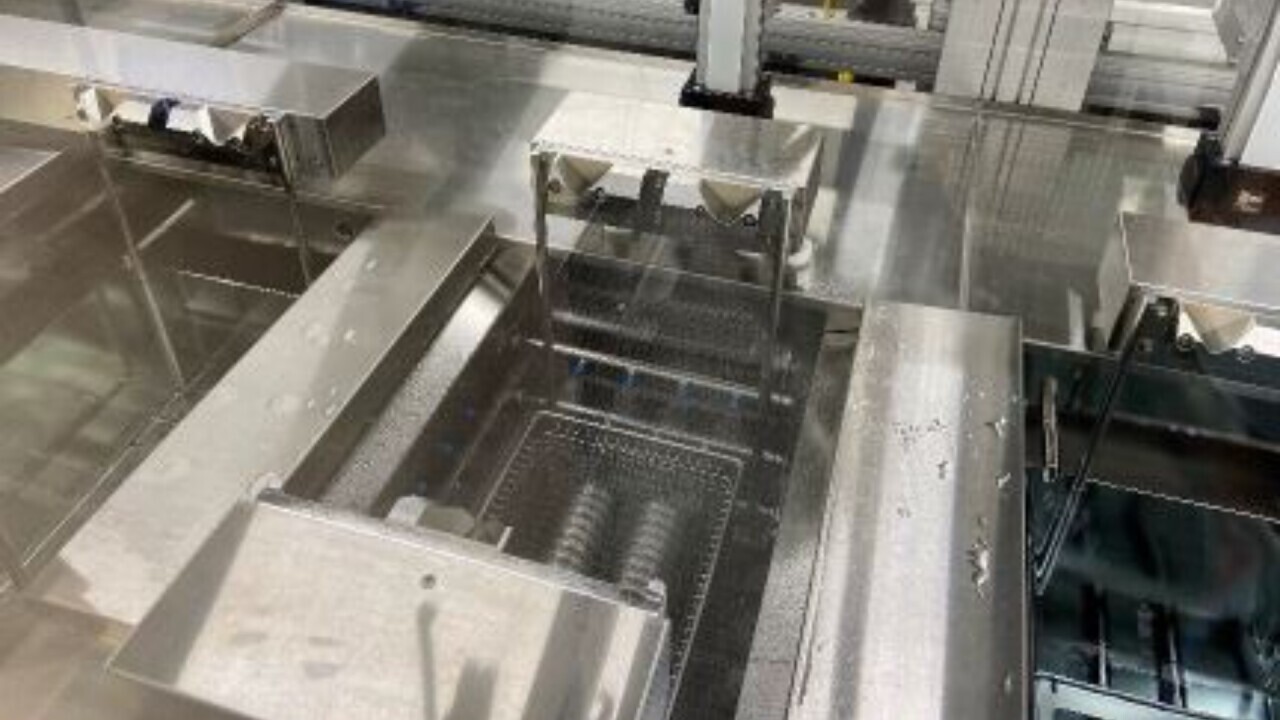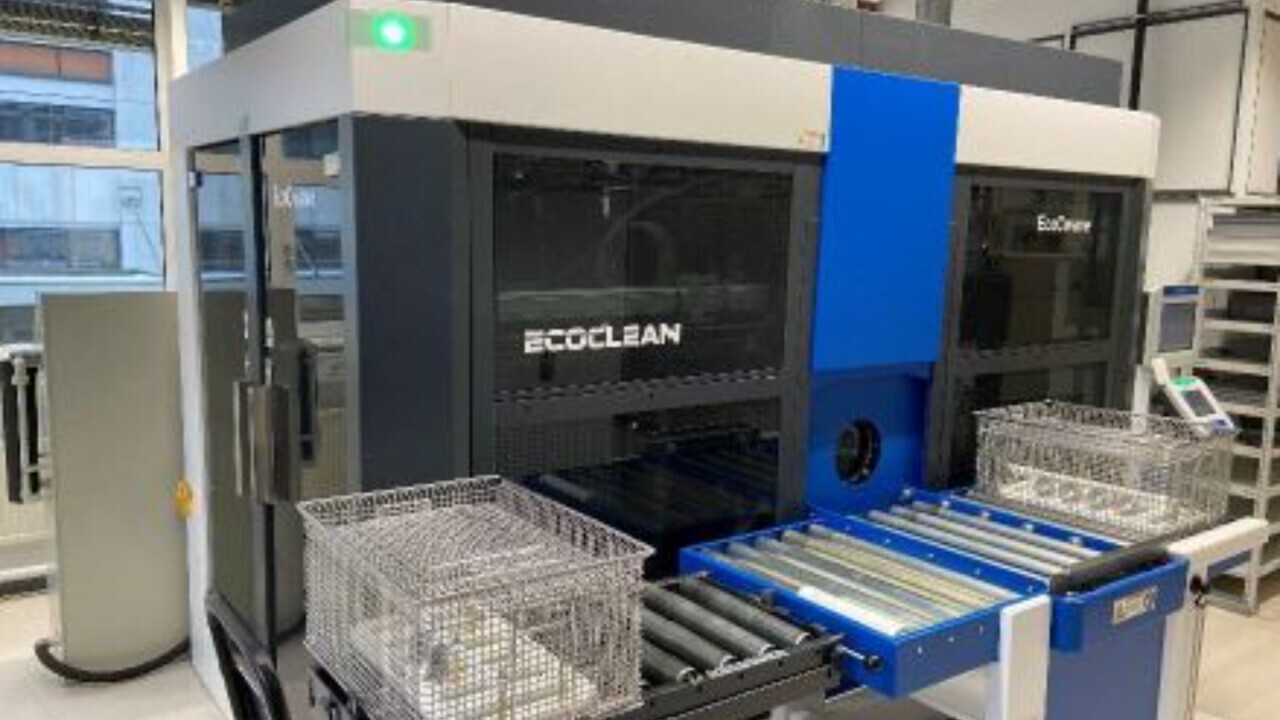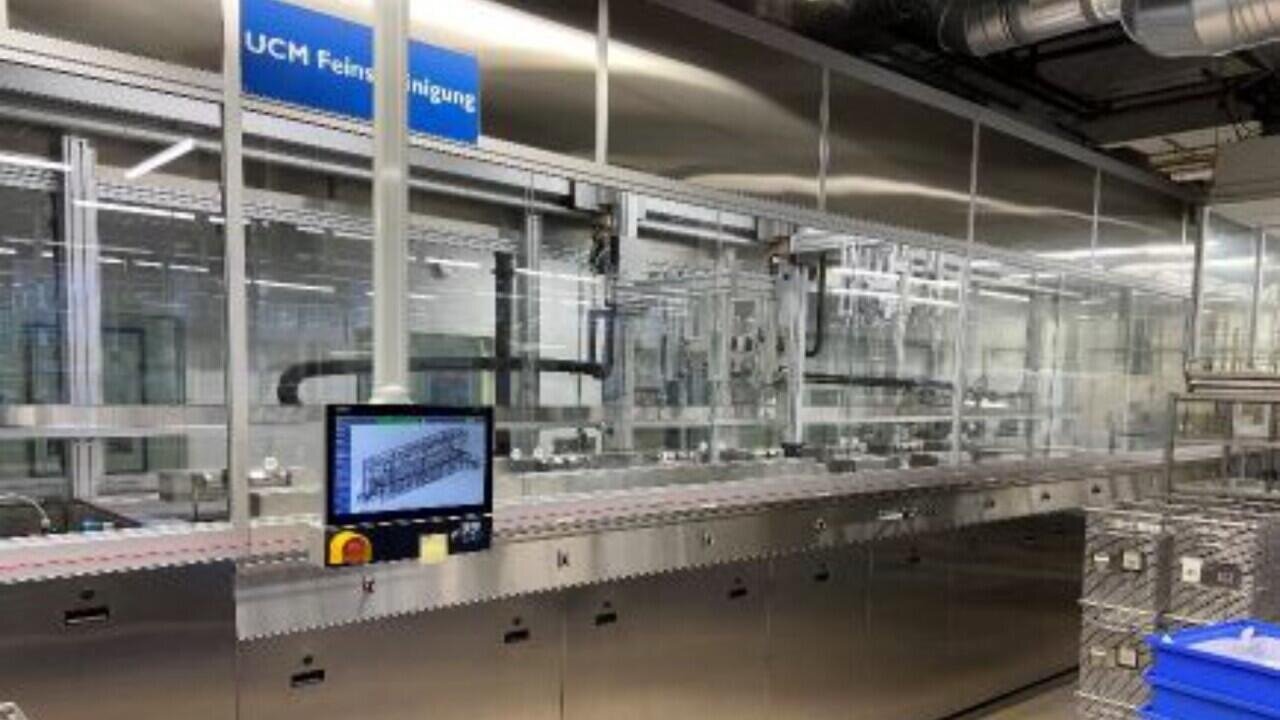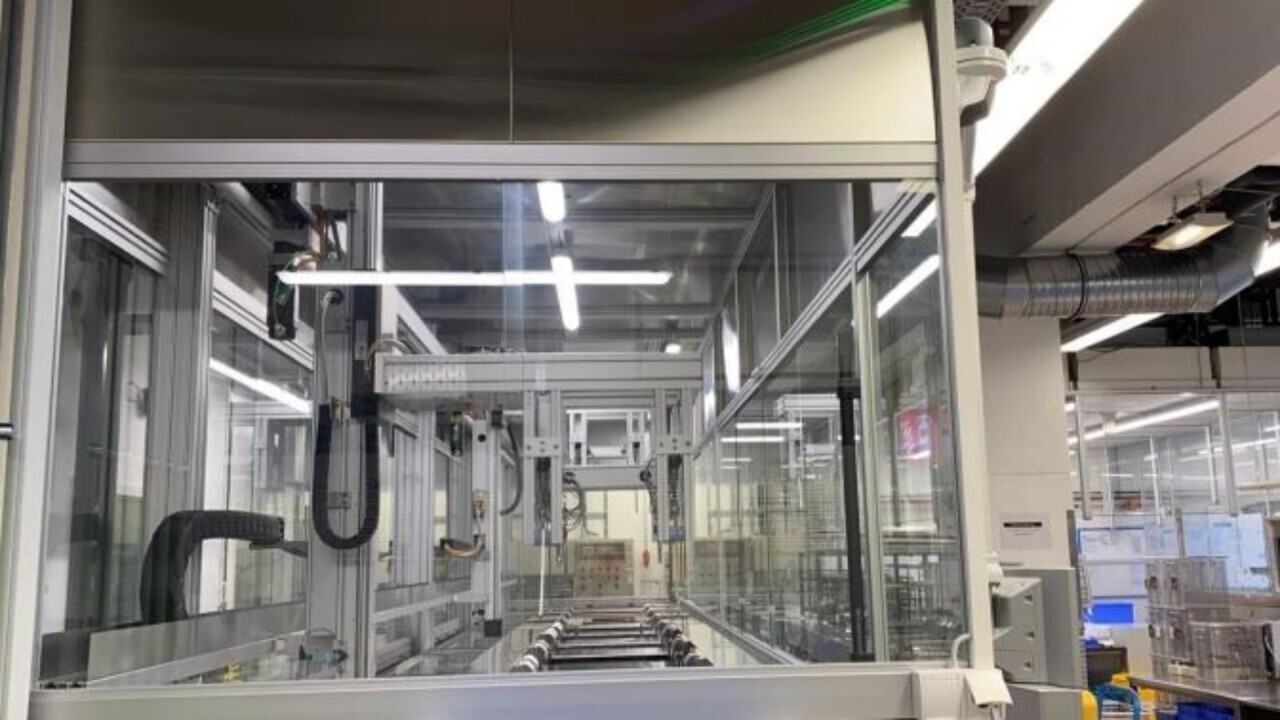Best practice MedtecLIVE 2024
Cleanliness for Optimal Diagnostics and Therapy
X-ray tubes are the basis of various diagnostic and therapeutic procedures in medicine. The manufacturing precision and cleanliness of the components are crucial for functional reliability and longevity. A leading manufacturer relies on systems from EECOCLEAN and UCM for cleaning.
-
The integrated spray rinse with deionized water removes even very fine dust particles still sticking to the surface after cleaning and the first immersion rinse. -
The components of spiral groove bearings are to be cleaned in a standard machine. Cleaning tests before the investment showed that only the EcoCwave can achieve the required results. -
The ultrasonic fine cleaning system, equipped with twelve treatment stations, ensures that the cleanliness specifications of two or less particles of 5 μm or one or less particle of 10 μm are reliably met when X-ray tube parts receive their final clean. -
The transport racks of the two transfer units have different grippers to pick up the various cleaning containers provided by the customer and carry out program-specific movements of the containers in the treatment stations.
Cleanliness for Optimal Diagnostics and Therapy — Reliable Cleaning of X-ray Tube Parts
X-ray tubes are the basis of a number of diagnostic and therapeutic procedures in medicine. Manufacturing precision and cleanliness of the individual parts are key factors for the functional reliability and longevity of these high-tech components. A leading manufacturer relies on equipment from Ecoclean and UCM for cleaning.
Shortly after the discovery of X-rays by Wilhelm Conrad Röntgen on November 8, 1895, the development and manufacture of X-ray tubes at Philips Medical Systems DMC GmbH began with Carl Heinrich Florenz Müller, a glassblower born in Thuringia. As early as March 1896, he made the first X-ray tube in his workshop in Hamburg. Three years later, the technology pioneer was granted the first patent for an X-ray tube with water-cooled anti-cathode. The breathtaking pace of tube development and the enormous success of X-ray technology spurred demand worldwide, turning the craftsman's workshop more and more into a specialist factory for X-ray tubes. In 1927, Philips, the only shareholder at the time, took over the factory.
Innovation and high manufacturing precision — also with regard to cleanliness
Ever since then, the company has been shaping X-ray technology with innovative solutions and continuous improvements. The products used in Philips Healthcare systems, as well as those sold under the Dunlee brand, contribute significantly to advances in diagnostic imaging, computer tomography and interventional radiology. ‘Besides modern manufacturing techno-logies, high precision and ongoing process optimi-zation, component cleanliness plays an important role in ensuring the functional reliability and longevity of our products,’ says André Hatje, Senior Engineer for Process Development in the X-ray Tubes Division. Residual particle contamination specifications that have to be met when cleaning the various X-ray tube parts underline this: a maximum of two 5 μm particles and one 10 μm particle.
Removing molybdenum grinding dust with a standard system
The high cleanliness requirements were one criterion when the plant for cleaning spiral groove bearing components was replaced. The bearings, which form the heart of high-tech X-ray tubes, are made of molyb-denum. After the groove structure has been applied by laser, a dry grinding step is performed. This is followed by cleaning, during which the grinding dust and any traces of smoke from the laser process still present in the grooves must be removed. To simplify process validation, among other things, a compact standard machining was needed for this cleaning process. Against this backdrop, the process developer approa-ched several cleaning equipment manufacturers, including Ecoclean GmbH in Filderstadt. ‘The cleaning tests conducted with the various manufacturers showed that we can only achieve the cleanliness we want for the spiral groove bearing parts with the EcoCwave from Ecoclean,’ reports the process developer.
Equipped for fine cleaning
The machine for immersion and spraying processes is operated with the same acidic cleaning medium previously used at Philips and has a footprint of just 6.9 m2. It is fitted with three flood tanks for the washing step and two rinsing processes. Their flow-optimized, cylindrical design and upright position prevent dirt from accumulating in the tanks. In addition, each tank has a separate media circuit with full-flow filtration so that the cleaning and rinsing fluids are filtered during filling and emptying as well as in the bypass. The deionized water used for the final rinsing process is treated in the integrated Aquaclean system. In line with the high cleanliness requirements, the working chamber and the roll-over unit are electropolished. The latter's sophisticated design also ensures that the parts are easily reached on all sides by the integrated ultrasonic system. Furthermore, frequency-controlled pumps allow the volume flow to be optimally adapted to the parts during flooding and emptying. As a result, the working chamber can be filled to different levels to achieve a more intensive media exchange in critical areas of components. The parts are dried by hot air and vacuum. ‘We are very satisfied with the cleaning result. All parts come out of the plant so clean that we can transfer them directly into a cleanroom for further processing,’ adds André Hatje. These next steps include annealing and coating the components with liquid metal.
Ultrasonic system for intermediate and final cleaning steps
The spectrum of parts that are cleaned at Philips in an 18-year-old, multi-stage ultrasonic machine from UCM AG ranges from small screws and anode plates to cathode sleeves and housing pots with a diameter of 225 mm. The metals from which the parts are made are equally diverse, comprising nickel-iron materials, stainless steel, molybdenum, copper, tungsten, and titanium. ‘The parts are cleaned after different processing steps, such as grinding and electroplating, as well as before annealing or brazing. Therefore this is the most frequently-used machine in our material supply system and it continues to deliver satisfactory cleaning results," reports André Hatje. However, the company had reached its limits in terms of capacity and therefore decided to invest in a second machine. It was clear that this should again come from UCM, the division of the SBS Ecoclean Group that specializes in precision and ultra-fine cleaning. Even though the existing machine was still capable of handling the process, the number of cleaning and rinsing steps, and the drying process, Philips wanted a new cleaning system that would be faster, more versatile, and deliver even better results. ‘Some components were not optimally cleaned in the intermediate cleaning stage. Although this does not impair the subsequent processes, after the final cleaning step the parts must be practically particle-free’” explains the process developer. This means that the specifications of two or less 5 μm particles and and one or less 10 μm size particles must be reliably met.
Designed for fast and highly flexible processes
Including loading and unloading, the fully enclosed ultrasonic cleaning system features twelve stations and two transfer units. They are freely programmable, as are the parameters of the processes to be carried out in the various tanks. The stations can thus be served as desired and the processes freely designed. ‘To meet the different cleanliness requirements for the various parts and downstream processes, with this system we use around 30 different cleaning programs, which are automatically selected via an integrated barcode system,’ explains André Hatje. The system’s transport racks are equipped with varying grippers. This enables the range of cleaning containers provided by the customer to be picked up as well as program-specific functions, such as lifting, lowering, and rotating the container, to be carried out in the treatment stations. Depending on the program, the feasible throughput is 12 to 15 baskets per hour in three-shift operation six days a week.
Effective solutions for optimal cleaning results
After loading, the first four tanks are designed for cleaning processes with intermediate rinsing steps. To achieve better results faster, the cleaning tanks are fitted with multi-frequency ultrasound (25 and 75 kHz) at the bottom and on two sides. Through the use of plate transducers flange-mounted in the tank walls, there are no components in the tanks where dirt can collect. A further innovation is that the cleaning tanks feature a bottom filtration system in addition to a two-sided overflow for discharging suspended and floating particles. This ensures that any removed impurities accumu-lating on the bottom are detached by a flushing nozzle and sucked off at the lowest point of the tank. The fluid from the surface and bottom filtration systems is treated via separate filter circuits. The cleaning tanks are also equipped with devices for electrolytic degreasing. ‘We already developed this function together with UCM for the old machine because it also enables us to get parts clean that have dried polishing paste on them,’ adds André Hatje. A new addition, however, is a spray rinsing device with de-ionized water integrated into the fifth treatment station; this also removes very fine dust still sticking to the surface after cleaning and the first immersion rinse. ‘This feature proposed by UCM also contributes significantly to a better cleaning result,’ remarks the process developer. Spray rinsing is followed by three immersion rinsing stations. For components made of ferrous materials, a corrosion inhibitor is added to the deionized water used in the last rinse cycle. All four rinse stations have separate lift-out equipment. This is used not only to lift the baskets out of the tanks after the defined dwell time, but also to agitate the parts during the rinse process. The next two stations are fitted with combined infrared vacuum dryers for drying the parts. In the unloading station, an enclosure with integrated laminar flow box prevents recontamination of the components. The new cleaning system gives us a lot more cleaning options, thus enabling us to achieve better cleaning results with shorter cycle times. That is why we are planning to have our old machine appropriately modernized by UCM,” concludes André Hatje.





